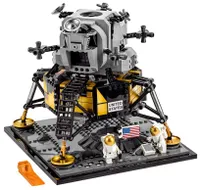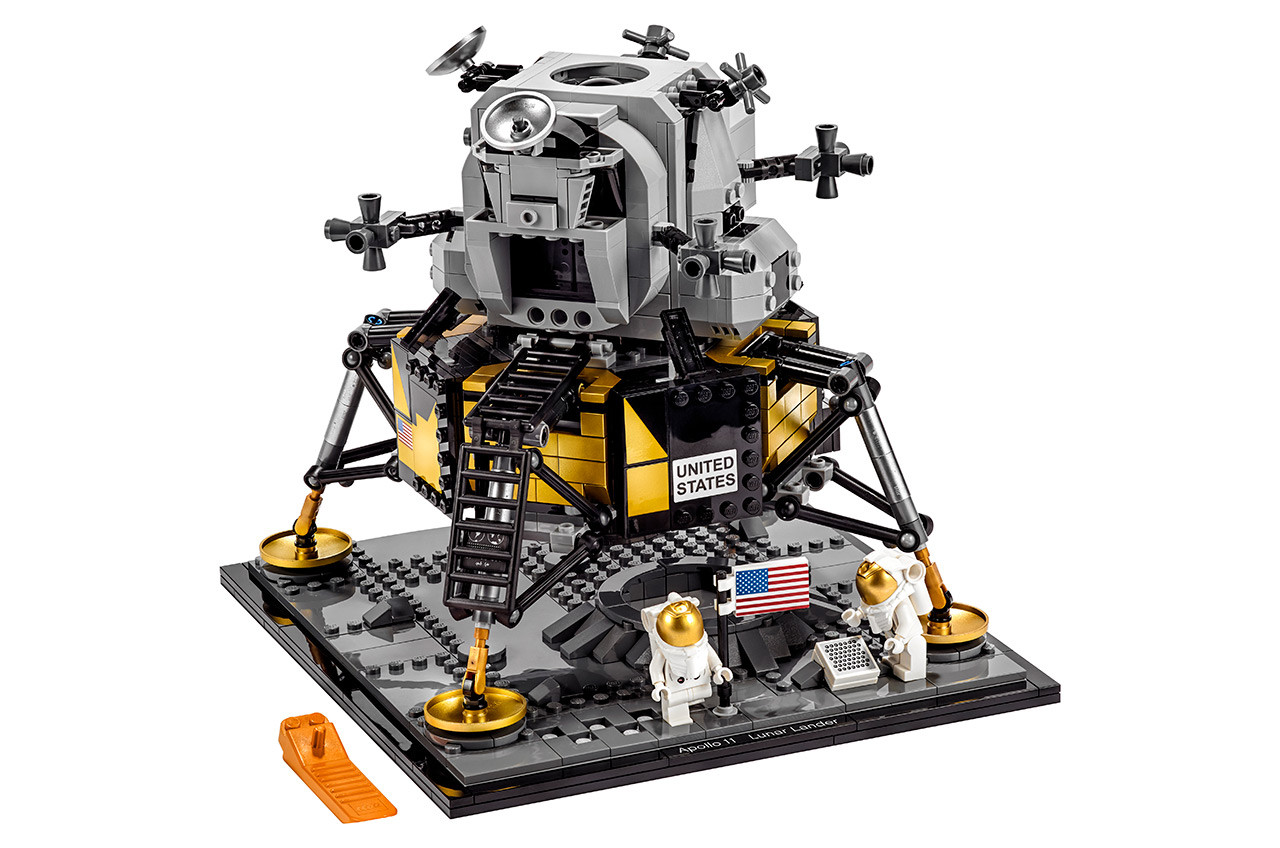The Lego 'Eagle' Has Landed: NASA Apollo 11 Lunar Lander Revealed
Lego has teamed up with NASA to launch a surprise toy set for the 50th anniversary of the first moon landing.
The "NASA Apollo 11 Lunar Lander," a new Lego Creator Expert set that recreates in detail the "Eagle" lunar module that brought Neil Armstrong and Buzz Aldrin to the lunar surface on July 20, 1969, was officially revealed on Thursday (May 30), two days before going on sale. The 1,087-brick model was developed by Lego, in cooperation with NASA, to celebrate the 50 years that have passed since the historic achievement.
"Celebrate space exploration with the NASA Apollo 11 Lunar Lander!" Lego announced. "This display model makes a great centerpiece for the home or office and provides a challenging and rewarding building experience full of nostalgia."
Related: Lego's Epic Apollo 11 Lunar Lander Set in Photos!
Lego Apollo 11 Lunar Lander: $99.95 at Amazon
Lego teamed up with NASA to make this special Apollo anniversary building set. The 1,087-piece kit includes the "Eagle" lunar module that brought Neil Armstrong and Buzz Aldrin to the lunar surface on July 20, 1969. Read the full story here.
The NASA Apollo 11 Lunar Lander will be available exclusively at Lego Stores and through the company's online shop beginning Saturday (June 1) for $99.99.
The Creator Expert set, which is recommended for ages 16 and older, assembles to form a 7-inch-tall by 8-inch-wide by 7-inch-deep (20-by-22-by-20-centimeter) diorama depicting the Eagle on the lunar surface, scaled to match Lego's iconic minifigures. Two of the figures are included, representing Armstrong and Aldrin. Each minifigure sports Apollo 11 spacesuit details and a helmet with a gold visor.
The set is designed such that the lander's descent and ascent stages can be separated. The lower, or descent, stage features new-for-Lego gold-colored landing pads and panels and has two opening bays. The Modularized Equipment Stowage Assembly, or MESA, platform can be lowered to reveal a toy brick version of the Westinghouse television camera that broadcast the live TV of Armstrong descending the ladder to the surface and taking his "one small step" and "giant leap for mankind."
Breaking space news, the latest updates on rocket launches, skywatching events and more!
Related: Apollo 11 Moon Landing: How It Worked (Infographic)
Another bay, on the side opposite the MESA on the Lego lander, represents the Early Apollo Scientific Experiment Package, complete with a deployable, toy version of the Laser Ranging Retroreflector (LRR), the only instrument left by Apollo 11 50 years ago that is still used today. The LRR, which is comprised of 100 mirrors, is used to precisely measure the distance from Earth to the moon.
The descent stage also features a simplified replica of the plaque attached to the same leg strut as Eagle's ladder. Like the real plaque, the Lego version includes maps of Earth's hemispheres and markings representing the inscription, "Here men from the planet Earth first set foot upon the moon, July 1969 A.D. We came in peace for all mankind," and the autographs of the Apollo 11 crew and the then-President of the United States, Richard Nixon.
The ascent stage is similarly finely detailed, with the small maneuvering thrusters and antennas that were externally mounted on the real spacecraft. The key feature of the Lego ascent stage, though, is its interior, with decal-adorned parts, lockers and other Lego bricks recreating the layout of the two-person — or in this case, minifigure — cabin.
The NASA Apollo 11 Lunar Lander model sits atop a simulated moon surface — a Lego version of Tranquility Base — that uses gray toy bricks to form a crater and astronaut boot prints. A U.S. flag and "Apollo 11 Lunar Lander" nameplate finishes off the diorama display.
The NASA Apollo 11 Lunar Lander builds off earlier Lego sets themed around the Apollo moon landings, dating back to 1975 and a 364-piece "Moon Landing" model that featured an all-blue lunar module and brick-built astronauts. Almost 30 years later, Lego partnered with Discovery Channel to offer a more accurate-to-Apollo "Lunar Lander" in 2003. That model was built from 457 bricks and included the first two minifigures sporting the NASA logo.
Most recently, the 2017 Lego Ideas' NASA Apollo Saturn V rocket, which remains available, had a lunar module that fit within the 3-foot-tall (100-centimeter) model.
Lego announced the new NASA Apollo 11 Lunar Lander for the 50th anniversary of the first moon landing on the same day it officially revealed seven Lego City Space building sets based on NASA's future missions to reach Mars. The sets, which draw inspiration from NASA's Space Launch System, Gateway and other Artemis program vehicles, will be available June 23 in the U.S. (June 1 globally).
Click through to collectSPACE for more photographs and video of Lego's NASA Apollo 11 Lunar Lander Creator Expert set.

Robert Pearlman is a space historian, journalist and the founder and editor of collectSPACE.com, a daily news publication and community devoted to space history with a particular focus on how and where space exploration intersects with pop culture. Pearlman is also a contributing writer for Space.com and co-author of "Space Stations: The Art, Science, and Reality of Working in Space” published by Smithsonian Books in 2018.
In 2009, he was inducted into the U.S. Space Camp Hall of Fame in Huntsville, Alabama. In 2021, he was honored by the American Astronautical Society with the Ordway Award for Sustained Excellence in Spaceflight History. In 2023, the National Space Club Florida Committee recognized Pearlman with the Kolcum News and Communications Award for excellence in telling the space story along the Space Coast and throughout the world.




